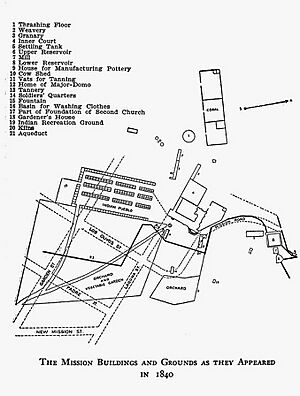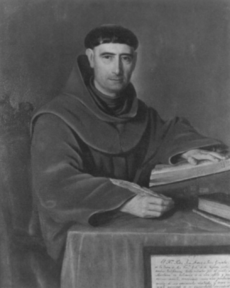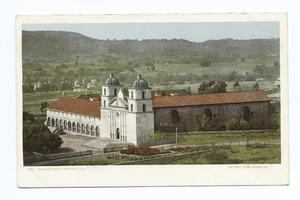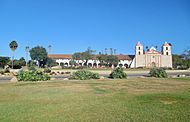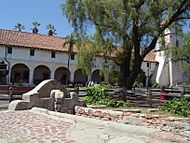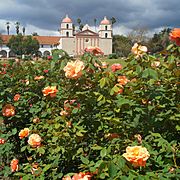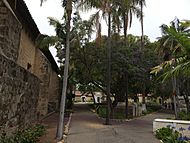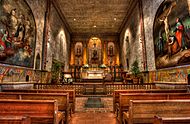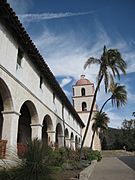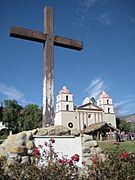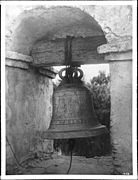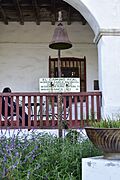Mission Santa Barbara facts for kids
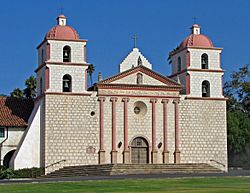
The capilla (chapel) at Mission Santa Barbara.
|
|
| Lua error in Module:Location_map at line 420: attempt to index field 'wikibase' (a nil value). | |
| Location | 2201 Laguna St. Santa Barbara, California 93105 |
|---|---|
| Name as founded | La Misión de La Señora Bárbara, Virgen y Mártir |
| English translation | The Mission of the Lady Bárbara, Virgin and Martyr |
| Patron | Saint Barbara of Greece |
| Nickname(s) | "Queen of the Missions" |
| Founding date | December 4, 1786 |
| Founding priest(s) | Father Fermín Lasuén |
| Built | 1820, 1925 (repair) |
| Architect | Ripoll, Father Antonio |
| Architectural style(s) | Colonial, Other, Spanish colonial |
| Founding Order | Tenth mission |
| Headquarters of the Alta California Mission System | 1833–1846 |
| Military district | Second |
| Native tribe(s) Spanish name(s) |
Chumash Barbareño, Canaliño |
| Native place name(s) | Xana'yan |
| Baptisms | 5,556 |
| Marriages | 1,486 |
| Burials | 3,936 |
| Secularized | 1834 |
| Returned to the Church | 1865 |
| Governing body | Roman Catholic Archdiocese of Los Angeles |
| Current use | Parish Church |
| Designated | October 15, 1966 |
| Reference no. | 66000237 |
| Designated | October 9, 1960 |
| Reference no. |
|
| Website | |
| http://www.santabarbaramission.org | |
Mission Santa Barbara is a historic Spanish mission located in Santa Barbara, California. It is often called the 'Queen of the Missions' because of its beauty. Father Fermín Lasuén started the mission for the Franciscan order on December 4, 1786. This date is also the feast day of Saint Barbara, who the mission is named after. It was the tenth of 21 missions built in Alta California.
The Spanish built missions like Santa Barbara to claim land in California. They also wanted to teach local Chumash people about the Spanish way of life and the Catholic faith. This meant big changes for the Chumash, including new farming methods and diseases. Many Chumash people joined the mission system during this time.
The city and county of Santa Barbara are named after the mission. The mission itself is named after the legend of Saint Barbara. She was a young girl who was killed by her father for being a Christian.
Mission Santa Barbara sits on a hill between the Pacific Ocean and the Santa Ynez Mountains. It is one of only two missions that have always been led by Franciscan Friars since it was founded. Today, it serves as a parish church for the Archdiocese of Los Angeles.
Contents
History of Mission Santa Barbara
Building the Mission
The early missionaries built three different chapels in the first few years. Each new chapel was bigger than the last. The first chapel, built in 1787, was made of logs with a grass roof. It was about 39 feet (12 m) long and 14 feet (4.3 m) wide.
In 1789, a second chapel was built using adobe bricks and roof tiles. It was larger, measuring 83 feet (25 m) long and 17 feet (5.2 m) wide. A third adobe chapel, even bigger, replaced it in 1793–94. This one was 125 feet (38 m) long and 26 feet (7.9 m) wide. Sadly, the 1812 Santa Barbara earthquake destroyed this third chapel.
Construction on the fourth mission church began in 1815 and finished around 1820. Canalino workers built it, likely guided by stonemason José Antonio Ramiez. The church's towers were badly damaged in the 1925 earthquake. However, strong buttresses helped the main walls stay standing.
Workers restored the church the next year, finishing in 1927. They carefully rebuilt it to look like the original, using the same materials. Later, they found the concrete foundation was crumbling, causing cracks in the towers. So, between 1950 and 1953, the front and towers were rebuilt again. The inside of the church still looks much like it did in 1820.
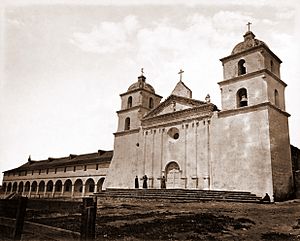
Some original mission structures are still visible today in Mission Historical Park. These were built by the Chumash people under Spanish rule. You can see old tanning vats, a pottery kiln, and a guard house. There was also a complex water system with aqueducts, a filtration system, and two reservoirs. A water-powered gristmill also used this water. The larger reservoir, built in 1806, supplied water to the city until 1993. The original fountain and lavadero (washing area) are also still near the mission entrance.
Life with the Chumash Tribe
Mission Santa Barbara was part of Spain's plan to protect its land in California. Spain wanted to turn local Chumash people into Spanish citizens. This meant they would become Catholic and join the Spanish economy.
The missions in the Chumash area mainly raised animals like cattle. They used animal products like hides and tallow (animal fat). The Santa Barbara Mission had over 14,000 animals between 1806 and 1810. Many Chumash workers were needed to care for these animals and help the mission.
These large herds changed the Chumash's traditional hunting and gathering lifestyle. European diseases also spread, which the Chumash had no protection against. This made life very difficult for the Chumash, and many felt they had no choice but to join the mission. Once baptized, they could not leave without permission from the padres (priests).
In 1818, two ships from Argentina, led by a French privateer named Hipólito Bouchard, threatened Santa Barbara. The padres, especially Father Antonio Ripoll, trained 180 Chumash people to defend the town. They formed an infantry unit with archers and machete-wielders, plus a cavalry unit with lancers. With their help, the Presidio soldiers faced Bouchard, who then sailed away without attacking.
Chumash Population Changes and Revolt
In 1803, about 1,792 Chumash people lived at the mission in 234 adobe huts. This was the highest number living there in one year. By 1820, the Chumash population dropped to 1,132, and then to 962 three years later.
In 1824, a Chumash revolt happened. Under the leadership of Andrés Sagimomatsee, the mission was briefly taken over. Soldiers there were disarmed and sent back to the Presidio. After a battle, most of the Chumash left for the mountains. Some even fled to Santa Cruz Island in plank canoes.
For a few months, the mission had very few Chumash people. Then, a pardon was arranged for their return by Father Presidente Vicente Francisco de Sarría and Father Antonio Ripoll. A military group went to find the Chumash who had fled. After negotiations, many Chumash, including women, children, and elders, returned to the mission. Some elderly and sick people died on the long journey back. By June 28, 1824, about 816 out of 1,000 had returned.
From 1836 to 1839, the number of Chumash at the mission continued to fall, from 481 to 246. By 1854, only a few Chumash lived near the mission. All California missions saw more deaths than births among the native populations. Modern historians believe this decline was due to difficult living conditions, hard work, poor food, and diseases.
After the Missions Changed Hands
In 1833, the Mexican government passed a law to take control of the missions from the church. This was called secularization. Father Presidente Narciso Durán moved the mission headquarters to Santa Barbara. This meant Mission Santa Barbara became home to about 3,000 important historical documents.
In 1840, California's Catholic Church was reorganized. Bishop Francisco Garcia Diego y Moreno made Mission Santa Barbara his main church, or cathedra. This made the mission chapel the temporary cathedral until 1849. It served as a temporary cathedral again from 1853 to 1876. This is why Mission Santa Barbara is the only California mission with two matching bell towers. At that time, only cathedrals had this special architectural feature.
In 1865, President Abraham Lincoln returned the missions to the Catholic Church. The mission's leader, Friar José González Rubio, had a disagreement with Bishop Amat about who should own the mission. The Franciscans eventually received the deed in 1925.
As a center for the Franciscans, the mission was important for education. From 1854 to 1885, it was a special college for future priests. From 1869 to 1877, it also taught regular students, becoming Santa Barbara's first college. This led to a high school seminary program in 1896, which became Saint Anthony's Seminary in 1901. The college program later moved and eventually became the Franciscan School of Theology (FST) in Berkeley, California.
Mission Santa Barbara Today
The city of Santa Barbara grew up around the mission and the harbor. Today, homes surround the mission, along with parks like Mission Historical Park. The Natural History Museum is also nearby.
Mission Santa Barbara now has a gift shop, a museum, a Franciscan Friary (where friars live), and a retreat house. It is a popular place for tourists to visit. The Franciscan Province of Santa Barbara owns the mission, and the local church rents the building from them. Since 2017, the mission has also been a training center for new Franciscan Friars.
The mission is also home to the Santa Barbara Mission-Archive Library. This library collects and saves historical items about Franciscan history and the missions. It has documents from the 1760s, including plans by Fray Junipero Serra. The library also has old California writings, maps, and images. It is a separate non-profit organization that helps scholars study mission history.
Mission Santa Barbara has the oldest continuous tradition of choral singing among all the California Missions. Two choirs, the California Mission Schola and the Cappella Barbara, perform during weekly Catholic services. The mission's archives hold a rich collection of old Franciscan music manuscripts.
Gallery
See also
- Spanish missions in California
- List of Spanish missions in California
- List of Catholic cathedrals in the United States
- List of cathedrals in the United States
- USNS Mission Santa Barbara (AO-131) – a Mission Buenaventura Class fleet oiler built during World War II.
- History of Santa Barbara, California
- California Historical Landmarks in Santa Barbara County, California


